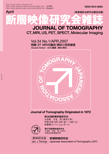3T MRI を用いた拡散テンソル画像
岡田 務、三木 幸雄、山本 憲 1)、伏見 育崇、森 暢幸、富樫 かおり
京都大学大学院医学研究科 放射線医学講座(画像診断学・核医学)
1)京都市立病院放射線科
Diffusion tensor neuroimaging using 3T MRI
Tsutomu Okada, Yukio Miki, Akira Yamamoto 1),
Yasutaka Fushimi, Nobuyuki Mori and Kaori Togashi
Department of Diagnostic Imaging and Nuclear Medicine, Graduate School of Medicine,
Kyoto University
1)Department of Radiology, Kyoto City Hospital
抄録
拡散テンソル画像は水分子の運動異方性を画像化することができる。脳白質は拡散異方性が高く、最も水分子が運動しやすい方向に線維束の走行が近似されていると考えられる。脳の拡散テンソル画像から白質線維束の3次元的構築を再構成することが可能であり、fiber tracking と呼ばれる。拡散テンソル画像とfiber tracking は脳病変において非侵襲的に白質構造の解析を行うことが可能となる。
最近のマグネットの進化、パラレルイメージング法の進歩により3テスラMRIの臨床応用が可能となってきた。3テスラMRIを用いた拡散テンソル画像は信号雑音比が高いなど1.5テスラと比較して異なる特長を持っている。拡散テンソルのパラメータ(fractional anisotropy: FA,mean diffusivity: MD など)を定量解析するには、これらの違いを考慮する必要がある。定量解析にはROI法が用いられてきたが、ROI描出における主観性を排除するために最近では全脳解析手法が導入されつつある。
3 テスラMRIを用いたfiber tracking は1.5テスラと比較して線維束の描出が改善すると考えられている。また、拡散テンソル画像を撮影する際の運動検出磁場(MPG)強度(b値)はテンソル計算に影響を与える。拡散テンソル画像の演算、fiber tracking にとって最適なMPG強度(b値)はまだ確立していない。錐体路fiber tracking と皮質下白質刺激による運動誘発電位を組み合わせて脳神経外科手術にfiber tracking は応用され、白質線維束のtracking と電気生理学的手法の結果はある程度一致することが報告されているが誤差もあり、さらに描出方法や精度を改善していく必要がある。
Abstract
Diffusion tensor imaging(DTI)can provide the information of directionally dependent(anisotropic)movement of water molecules. Brain white matter shows high diffusion anisotropy, and direction of maximum diffusivity has been shown to coincide with the white matter fiber orientation. DTI of the human brain can be reconstructed to display 3-dimensional macroscopic fiber tract architecture, in a process known as fiber tracking technique. DTI and fiber tracking offer noninvasive tools for studying cerebral white matter pathology.
With recent advances in 3 T magnets and technical development in parallel imaging technique, 3 T imaging has become practical in clinical settings. DTI using 3 T has different characteristics compared to 1.5 T, including better signal to noise ratio. The differences have to be taken into consideration when quantitative analyses of fractional anisotropy(FA)or mean diffusivity(MD)are performed. ROI analysis was applied for quantitative analysis of DTI, but the results were dependent on subjective ROI manipulation. To overcome this problem, whole brain analysis has been introduced into DTI.
Fiber tracking in 3 T has supposed to visualize white matter fiber tracts better than 1.5 T. The intensities(b values)of motion probing gradients(MPGs)is an important factor for calculating DTI parameters. The optimal intensities(b values)in MPG for DTI calculation and for fiber tractography are still in argument. Complementary use of corticospinal tract tracking and subcortical motor evoked potential have been applied in neurosurgical operations, and the course of eloquent fiber tracts depicted by fiber tracking was comparable with white matter stimulation during the operation, although errors between the two methods still remains.
Key words
Diffusion tensor imaging, whole brain analysis, number of motion probing gradient, fiber tracking validation, subcortical mapping |

